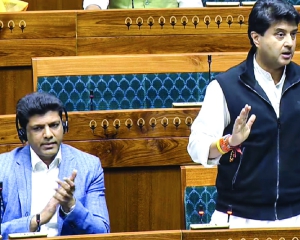Can India truly trust the US in moments of strategic need, especially with transactional leadership styles like Trump’s resurfacing? The past offers warnings, and the present demands clear-eyed realism
Whenever the issue of the United States as a strategic military ally of India is discussed, discomforting memories of the past resurface. In 1971, when Indian forces were on a blitzkrieg in what was then East Pakistan (later, Bangladesh), the US had ordered its Seventh Fleet’s ‘Task Force 74’ to sail menacingly into the Bay of Bengal. As a complicit partner of Pakistan, the US had overlooked the genocidal actions of the Pakistanis and instead adopted a threatening posture against India.
It was a complete public relations disaster for the US is one thing, but the reiterative wrongs of the US actions to be on the wrong side (when Pakistanis created mujaheddins in 80’s and re-directed terror towards India) in the hyphenated Indo-Pak equation till late 1990’s, is factual. Only when the products of Pakistan’s ‘terror nurseries’ started rebounding and attacking US interests, did the US recoil.
Today, the world has evolved with newer geopolitical realities and threats that call for recalibration of alliances and perspective. China looms large on the global stage with its expansionist tendencies and that naturally makes India the most credible ‘pivot’ to counter the same, for the US. Beyond convergence on Sino-wariness, the additional threat from religio-terrorism (supported duplicitously by China’s ‘steel brother’ Pakistan) has brought about a more positive bind in the US-India realm. Consequently, recent times have seen unprecedented growth of bilateral trust and engagement that has manifested in increased trade, transfer of weaponry and technology, nuclear deals and strategic jointsmanship, e.g. QUAD etc.
All this has led Delhi to shed the shibboleths of the past and usher into a more realpolitik-led nuance that it describes as ‘strategic autonomy’. Basically, it suggests walking the most optimum path for India’s security without getting constrained with the compulsions of belonging to any binary ‘bloc’. This enabled India to acquire cutting edge weaponry like Hellfire missiles, MQ 9B Drones, Apache attack helicopters etc. from the US, and simultaneously S-400 missile batteries, Akula-II nuclear submarines, Kamov KA-226 etc., from the Russians. Such flexibility allows for sourcing the most optimum weapon given various considerations, as also hedging against known and unknown risks of overdependence on one source.
Therefore, while the sourcing for armaments has gone up considerably from the ‘Western’ nations (even South Korea recently), the dependence on Russian vendors to keep legacy platforms functional, continues. Questions about price-versus-quality (read Russian-versus-Western) always abound, and this along with other tropical considerations e.g., timelines, reliability of spare, maintenance costs etc., determines which nation to source weapons from.
One underlying and often unsaid consideration has always been about the reliability of the alliance with the sourcing country. Questions of supplying country’s reliability lurk with murmurs of a proverbial ‘kill switch’ (backdoor stop for deactivation of weapons platform at the hands of supplying nation) or simply stopping spares, munitions and other wherewithal that could render the platform inefficacious, at critical times. However, while sourcing from Russia has gone down substantially for a variety of good reasons, history is instructive that whenever India has faced external hostility or concerning shortfalls - the Russians have never let India down in terms of supplies et al. The reliability of Russians has been time-tested and perhaps that of the USA as a military supplier, briefly tested in the immediate aftermath of the bloody Summer of 2020 (Indo-Chinese standoff), when it expedited supplies.
However, it made good commercial sense for the Americans and the weaponry that it supplied then was aimed at its own nemesis i.e., China - but would that ‘ally’ spirit be honoured in similar measure had India sparred against an US-ally (even someone like Pakistan?). One can only conjecture, except that that current geopolitics does pit US and India as ‘natural’ allies circumstantially, though it requires more test of time and situations.
It is here that the behaviour of the USA via-a-vis India in recent times (even if it were to be in the commercial realm) under Trump 1.0.2 has yet again triggered queries of reliability and trust. The ensuing trade/tariff war has afforded no special leniencies or generosity of treatment to India, as could be expected of a special or natural ‘ally’ (neither have the NATO/EU countries and allies been spared). Instead, Trump has demonstrated an intent and willingness to inflict as much pain onto other countries (including allies) to further its own interest unilaterally - without considering the urgencies and vulnerabilities of allies. This does not make for reassuring optics.
Former US Secretary of Defense (from previous Trump administration), James Mattis, had bemoaned, “strength of a nation is inextricably linked to the strength of our unique and comprehensive system of alliances and partnerships†and added “we cannot protect our interests or serve the role effectively without maintaining strong alliances and showing respect to those alliesâ€.
As a military man well-versed with the importance of trust and ‘allies’, Mattis had called out Trump’s brazen insensitivity that would be counterproductive in the long run. Today, Trump shows the same indifference and selfishness with another lever of governance i.e., economics, that augurs badly in terms of building trust in the US as a military supplier or ally.
Trump may not have a long memory, but other countries do, and that lack of trust amongst so-called allies will haunt the US in the long run.
(The author is Lt Gen Bhopinder Singh (Retd) and former Lt Governor of Andaman and Nicobar Islands & Puducherry. Views are personal)



























